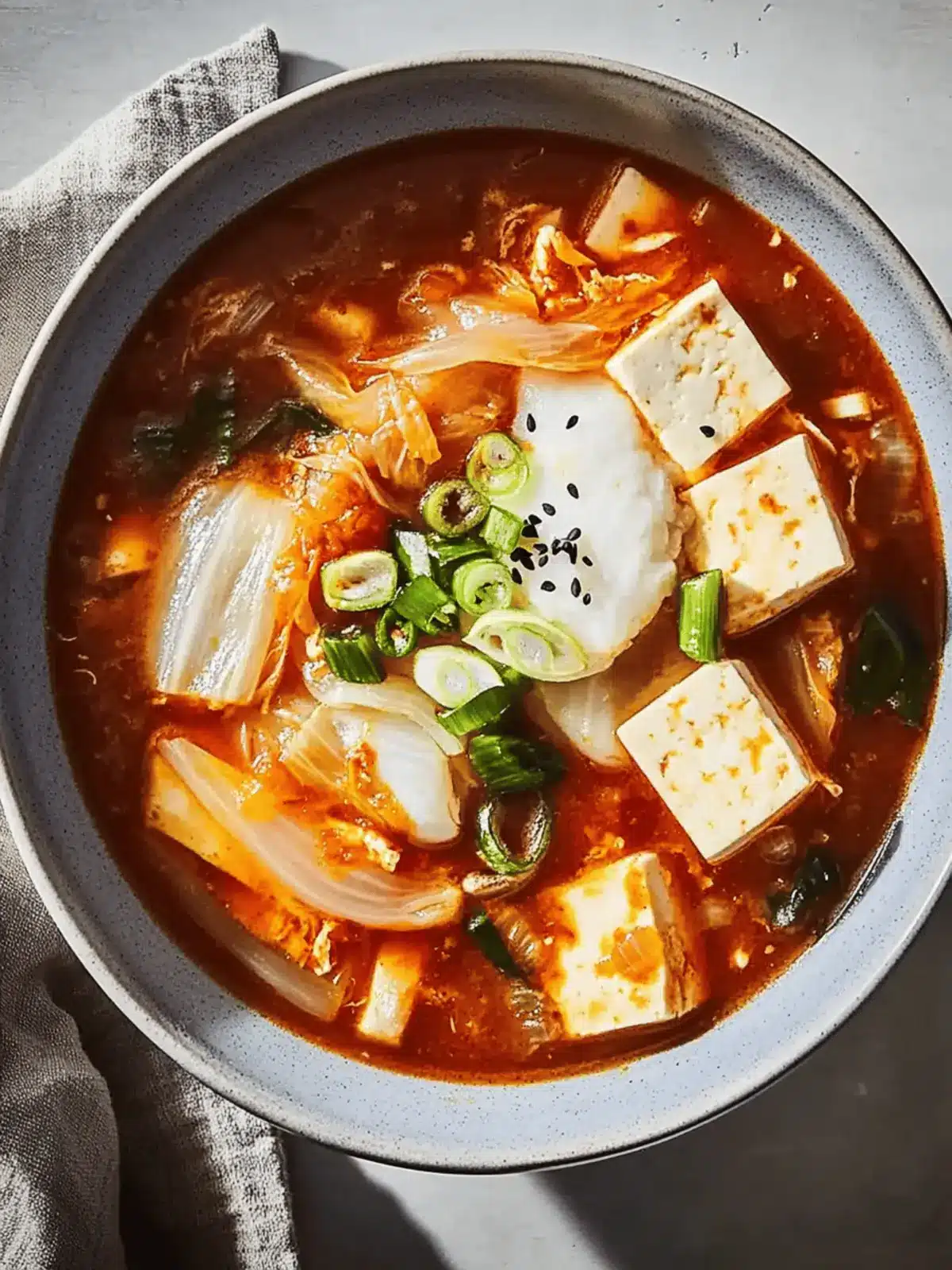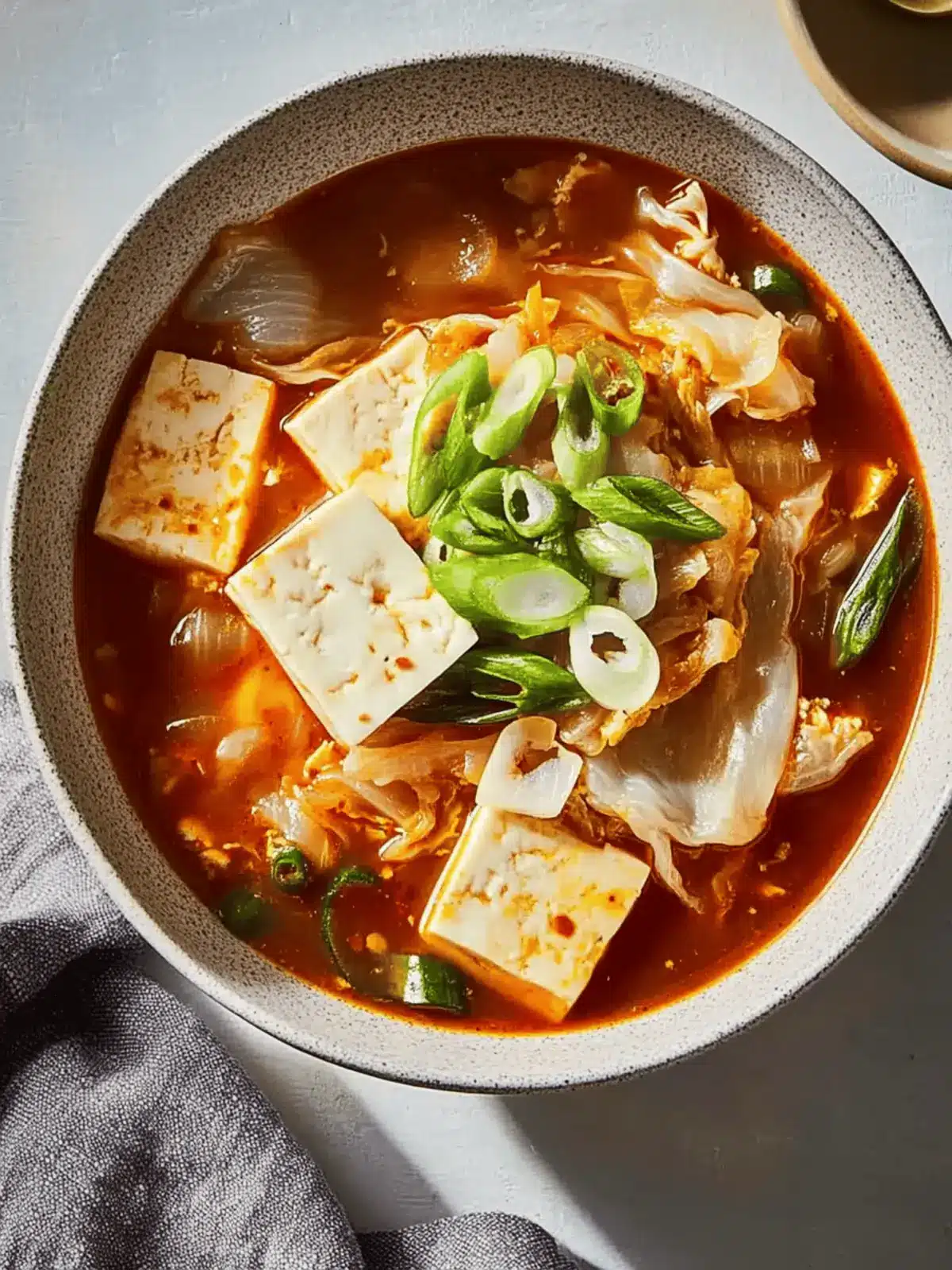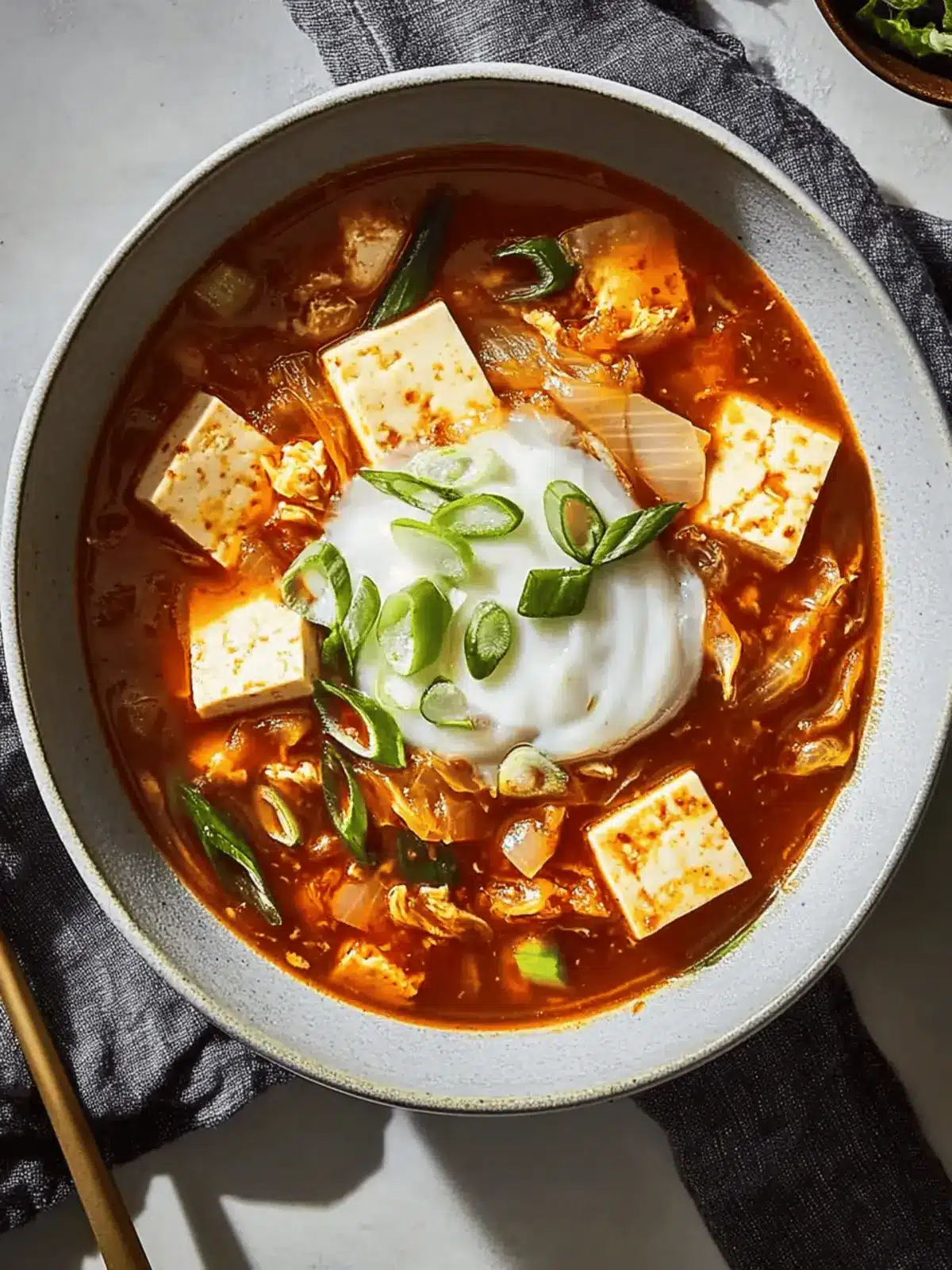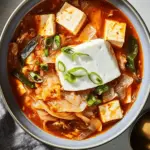There’s nothing quite like the vibrant zing of kimchi to awaken my taste buds, especially on a chilly evening. When I first combined this uniquely fermented delight with tender tofu and a fragrant broth, I knew I had stumbled upon a comforting treasure: my Kimchi-Tofu Soup. It’s become my go-to dish when I crave something hearty yet refreshingly different.
Picture this: a pot that simmers gently, filling the room with the cozy warmth of garlic and ginger, while colorful ingredients dance together in perfect harmony. This recipe is not only a treat for the palate but an easy way to boost your vegetable intake without sacrificing flavor. Whether you’re looking to impress at a dinner party or simply want a night of relaxation with a warm bowl in hand, this soup has got you covered. Let’s dive into the delightful world of Korean-inspired flavors and transform your weekday meals!
Why is Kimchi-Tofu Soup a must-try?
Comforting warmth: This bowl of goodness is perfect for chilly nights, offering a cozy hug in every spoonful.
Zesty kick: The kimchi infuses a vibrant flavor that livens up your usual soup routine. It’s a great way to shake off the fast food blues!
Wholesome ingredients: Packed with nutritious tofu, crisp veggies, and sautéed aromatics, it’s a health boost you can truly enjoy.
Quick and easy: With minimal cooking time and straightforward instructions, you can whip this up even on busy evenings.
Crowd-pleaser: The combination of flavors appeals to everyone, making it an ideal choice for family dinners or gatherings.
Kimchi-Tofu Soup Ingredients
• Gather everything you need for this flavorful dish!
For the Broth
- Neutral oil – 3 tablespoons, divided for sautéing and frying delicious tofu.
- Garlic paste – 1 tablespoon, for an aromatic base that enhances the overall flavor.
- Ginger paste – 2 teaspoons, offering a warm spice that complements the kimchi beautifully.
- Lower-sodium vegetable broth – 4 cups, a lighter alternative that keeps it wholesome.
For the Soup
- Kimchi – 2 cups, drained; this is the star of your kimchi-tofu soup, adding bold and tangy notes.
- Classic coleslaw mix – 2 cups, bringing in crunchy texture and additional veggie goodness.
- Extra-firm tofu – 1 (14 ounce) package, drained and cubed; it’s packed with protein and soaks up flavors wonderfully.
- Scallions – 5 medium, cut into 1-inch pieces for fresh bites and a mild onion taste.
- Reduced-sodium soy sauce – 1 tablespoon, adding depth without overwhelming the flavors.
For Serving
- Large eggs – 4, fried to your preference, providing a rich finish to each bowl.
- Toasted sesame oil – 1 tablespoon, adding a nutty aroma that elevates the dish.
- Toasted sesame seeds – 1 tablespoon, for a delightful crunch and visual appeal.
How to Make Kimchi-Tofu Soup
-
Heat oil: Start by heating 1 tablespoon of neutral oil in a large pot over medium heat. Wait for the oil to shimmer slightly, indicating it’s ready for the next ingredients.
-
Sauté aromatics: Add the garlic paste and ginger paste, sautéing them for 1-2 minutes until they emit a fragrant aroma. This step lays a flavorful foundation for your soup!
-
Simmer broth: Carefully pour in the lower-sodium vegetable broth and bring it to a gentle simmer. You want the broth to heat through, releasing its comforting essence.
-
Combine veggies: Toss in the kimchi and classic coleslaw mix, stirring well to ensure everything is combined nicely. Watch for the vibrant colors as they meld into a delicious mix.
-
Brown tofu: In a separate pan, heat the remaining 2 tablespoons of oil over medium-high heat. Add the cubed tofu and cook until it’s golden brown on all sides, about 8-10 minutes, for a satisfying texture.
-
Mix it up: Once the tofu is golden, transfer it into the pot with the broth mixture, along with the scallion pieces. Stir in the reduced-sodium soy sauce, allowing flavors to meld beautifully.
-
Fry eggs: In another pan, fry the eggs to your desired doneness—sunny side up works wonderfully here! The rich yolks will enhance the soup’s comforting nature.
-
Serve hot: Ladle the soup into bowls, topping each with a fried egg, a drizzle of toasted sesame oil, and a sprinkling of sesame seeds for a delightful finish.
Optional: Garnish with additional scallions for an extra fresh bite.
Exact quantities are listed in the recipe card below.
What to Serve with Kimchi Tofu Bowl?
Elevate your dining experience by creating a delightful spread that harmonizes beautifully with this vibrant kimchi-infused dish.
-
Steamed Jasmine Rice: A subtle base that perfectly absorbs the flavorful broth, making every bite more satisfying.
-
Spicy Pickled Vegetables: These tangy morsels add a crunchy texture and enhance the overall flavor profile for a delicious contrast.
-
Sesame Garlic Green Beans: Sautéed until tender, these green beans add bright color and a nutty taste that complements the kimchi.
-
Crispy Wontons: Their crunchy exterior provides a satisfying contrast to the warm, soothing soup, enticing you with every bite.
-
Cucumber Salad: This refreshing side, drizzled with rice vinegar, offers a cooling effect to balance the zesty heat of the kimchi.
-
Chilled Soju or Sake: These light, crisp drinks pair wonderfully, cleansing the palate and enhancing your culinary journey.
-
Mango Sticky Rice for Dessert: End on a sweet note with this creamy delight, providing a pleasing closure to your meal.
Imagine gathering your loved ones around a table, enjoying not just comfort but community in each bowl. This meal is more than just food; it’s an embrace, waiting to be served!
Kimchi-Tofu Soup Variations
Feel free to play around and make this recipe your own with these delightful twists and swaps!
-
Spicy Kick: Add 1-2 teaspoons of gochujang (Korean chili paste) for a fiery punch that elevates the flavor profile dramatically.
-
Vegetable Boost: Swap in 1 cup of spinach or kale instead of coleslaw mix for an extra dose of green goodness that blends seamlessly.
-
Grain Options: Serve over cooked rice or quinoa instead of empty bowls; these grains add heartiness while soaking up the delicious broth.
-
Umami Upgrade: Mix in a tablespoon of miso paste into the broth for a rich, savory depth that amplifies every spoonful.
-
Protein Swap: Substitute the tofu with chickpeas for a delightful twist, adding a nutty flavor and more fiber while keeping it plant-based.
-
Creamy Addition: Stir in a splash of coconut milk towards the end for a creamier, richer texture that warms the soul on cold nights.
-
Herb Infusion: Top your soup with fresh cilantro or basil for a refreshing burst that brightens the flavor and looks stunning.
-
No Egg Variation: For a vegan option, omit the eggs entirely or replace them with scrambled silken tofu for a similar comforting experience.
Make Ahead Options
These Kimchi-Tofu Soup preparations are perfect for busy weeknights! You can chop the scallions, cube the tofu, and even sauté the garlic and ginger paste up to 24 hours in advance, helping you streamline your cooking process. Store the prepped components separately in airtight containers in the refrigerator to maintain freshness. You can also prepare the broth with kimchi and coleslaw mix and refrigerate it for up to 3 days. When you’re ready to serve, simply heat the broth mixture, add the browned tofu, and fry your eggs to your liking. This way, you’ll enjoy comforting, delicious Kimchi-Tofu Soup with minimal effort!
Expert Tips for Kimchi-Tofu Soup
-
Fresh Ingredients: Use fresh kimchi for the best flavor and probiotic benefits. Avoid using aged kimchi as it may overpower the dish.
-
Perfect Tofu: Press tofu before cubing to remove excess moisture. This helps it brown nicely and absorb the soup’s rich flavors.
-
Adjust Spice Level: If you want a milder soup, rinse the kimchi briefly before adding it. This can tone down its heat without losing the essence of your kimchi-tofu soup.
-
Variations Welcome: Feel free to add other vegetables like mushrooms or bok choy for extra nutrition and variety. Just make sure they cook evenly with the other ingredients.
-
Storage Tips: If storing leftovers, keep the fried eggs separate to prevent them from becoming soggy. The soup reheats beautifully but it’s best enjoyed fresh!
Storage Tips for Kimchi-Tofu Soup
Fridge: Store leftover kimchi-tofu soup in an airtight container for up to 3 days. Keep it cool and flavorful by refrigerating promptly after serving.
Freezer: Freeze the soup for up to 2 months in a freezer-safe container. To preserve the texture, consider leaving out the fried eggs and adding them fresh when you reheat.
Reheating: Gently reheat the soup on the stovetop over low heat, stirring occasionally. If frozen, thaw overnight in the fridge before reheating for the best flavor in your kimchi-tofu soup.
Egg Storage: For the best experience, fry fresh eggs each time you serve the soup instead of freezing them alongside the soup. This keeps the texture delightful!
Kimchi-Tofu Soup Recipe FAQs
How do I choose the best kimchi for my soup?
Absolutely! When selecting kimchi, go for a fresh, crunchy variety that has a bright color and a pleasant aroma. Avoid kimchi that has dark spots or looks overly soggy, as this can indicate it’s past its prime. Fresh kimchi provides the vibrant zing needed for a delicious kimchi-tofu soup.
What’s the best way to store leftovers?
Very! After enjoying your meal, simply transfer any leftover kimchi-tofu soup into an airtight container. It can be stored in the fridge for up to 3 days. Be sure to refrigerate it promptly to keep the flavors intact!
Can I freeze kimchi-tofu soup?
Absolutely! You can freeze the soup for up to 2 months. However, it’s best to leave out the fried eggs when freezing, and add them fresh upon reheating. To freeze, let the soup cool completely, then pour it into a freezer-safe container, leaving some space for expansion.
How do I reheat the soup after freezing?
Very straightforward! To reheat frozen kimchi-tofu soup, first thaw it overnight in the fridge. Once thawed, gently heat it on the stovetop over low heat, stirring occasionally. If needed, add a splash of water or broth to adjust the consistency, and fry fresh eggs just before serving for that perfect finish.
Are there any dietary concerns I should consider?
For sure! If you’re cooking for someone with allergies, be aware that soy sauce contains gluten. You can substitute it with a gluten-free soy sauce or tamari. Additionally, if you have pet-friendly dietary restrictions, ensure that ingredients like scallions and garlic are kept out of any dish intended for pets, as they can be harmful to them.
What do I do if my soup is too spicy?
Don’t worry! If you find your kimchi-tofu soup a bit too spicy, you can tone it down in a couple of ways. First, consider rinsing your kimchi briefly under cold water to reduce its heat before adding it to the pot. Another option is to add a spoonful of coconut milk or cream, as it helps to mellow out spiciness while adding a creamy texture. Enjoy experimenting!
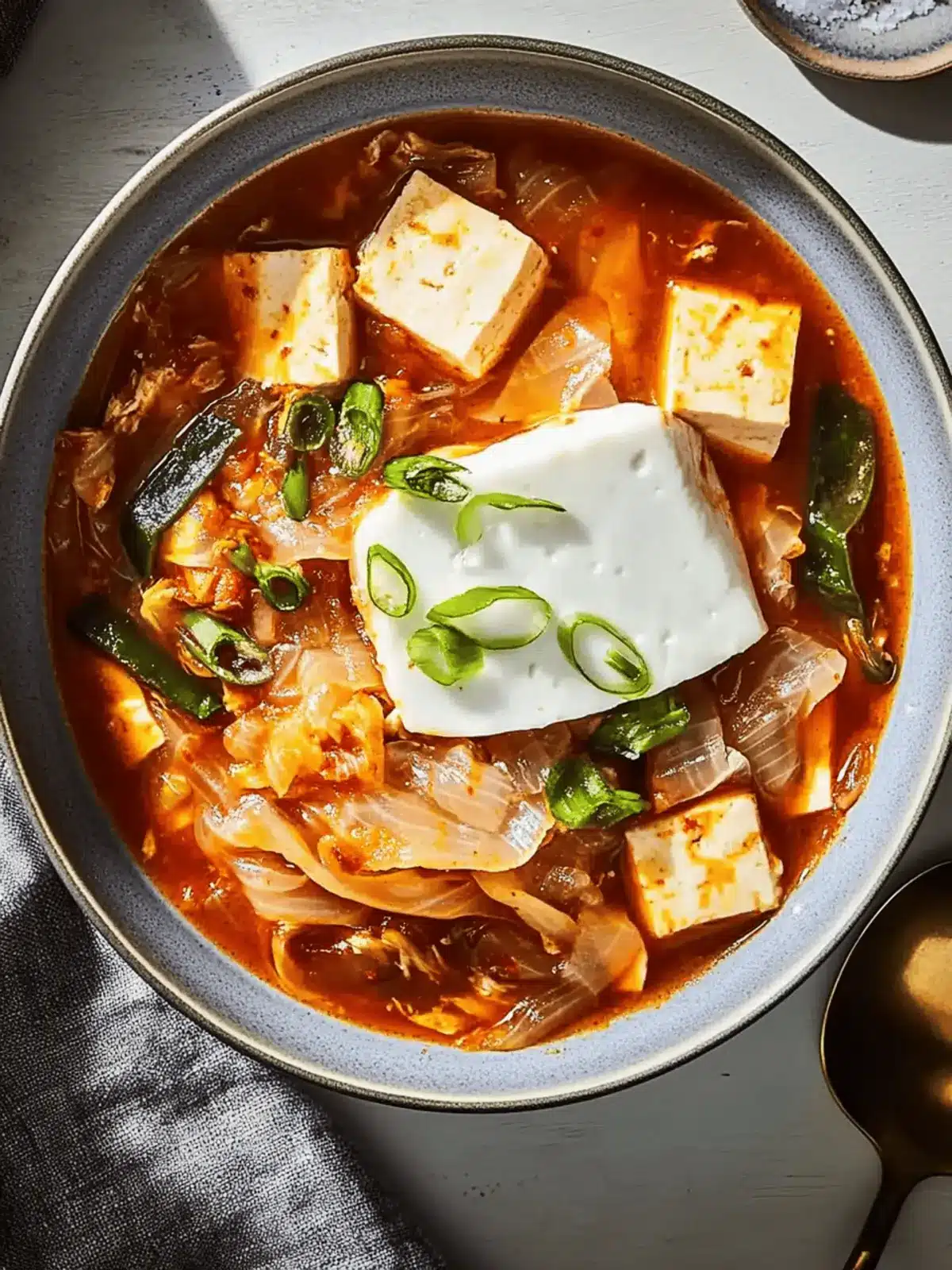
Savory Kimchi-Tofu Soup: A Bold Twist to Comfort Food
Ingredients
Equipment
Method
- Start by heating 1 tablespoon of neutral oil in a large pot over medium heat.
- Add the garlic paste and ginger paste, sautéing for 1-2 minutes.
- Pour in the vegetable broth and bring to a gentle simmer.
- Toss in the kimchi and coleslaw mix, stirring well.
- In a separate pan, heat 2 tablespoons of oil and brown the cubed tofu for 8-10 minutes.
- Transfer the tofu into the pot with the broth, along with scallions and soy sauce.
- Fry the eggs to your desired doneness.
- Serve the soup hot, garnished with a fried egg, sesame oil, and sesame seeds.

